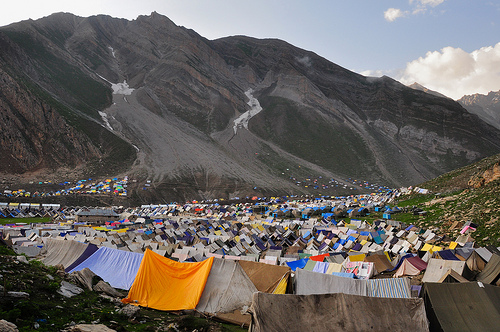SRINAGAR: Hundreds of thousands of pilgrims flocking to holy sites in the Himalayas are fouling fragile mountain ecosystems with rubbish, human waste, air pollution and the deforestation that comes with development.
Pilgrims believe the Himalayas are the abode of Lord Shiva, the god of destruction and regeneration, and devotees trek through treacherous mountain passes every year to seek Shiva’s blessings at various holy shrines.
But a rise in pilgrimages to these once pristine areas have made the region a dumping ground for hundreds of tonnes of garbage and human waste which is contaminating nearby rivers, environmentalists say.
Many environmentalists say the over-exploitation of ecologically sensitive Himalayas – for hydropower and religious tourism – over the last few decades worsened the level of destruction.
“Increased pilgrims to these areas is definitely taking its toll on these once beautiful and clean areas,” said WWF official.
“Plastic rubbish is found littered everywhere, nearby rivers are filled with human waste and roads have been built bringing in daily buses packed with pilgrims which is contaminating the air.”
PLASTIC RUBBISH, HUMAN WASTE
The Himalayan mountain range stretches across India, Bhutan, China, Nepal, Pakistan and Afghanistan and is often referred to as the “Roof of the World”.
There are several popular Himalayan pilgrimage sites — including Amarnath in Kashmir region, Gangotri, Kedernath and Badrinath in the northern state of Uttarakhand, as well as Mount Kailash and Lake Mansarovar in western Tibet.
Cashing in on India’s economic boom and a rapidly growing middle class, many tour operators are now offering package tours to holy Himalayan sites.
The commercialisation of pilgrimages, some of which offer helicopter rides, has brought in hotels, guest houses, restaurants and roads.
Efforts have been made to clean up sites like the Amarnath shrine, where devotees flock to worship an ice stalagmite which forms every year and is believed to be a form of Shiva, but local volunteers say more needs to be done.
“Last year we tried to clean a portion of the track, but our efforts can only be termed as a drop in the ocean,” said an Qayoom Farooqi a local environmentalist.
Environmentalists say Gangotri, the origin of the Ganges river which pilgrims believe to be sacred, has become a shanty town filled with filth left by around 800,000 pilgrims a year.
Experts say trees are being chopped down for firewood and to make way for hotels and roads, and human interference is even speeding up the melting of glaciers.
“It is not just greenhouse gases which are leading to melting glaciers, but it is also increased human activity and development in the Himalayas,” said a glaciologist.
“These ecosystems are very, very sensitive to human interference and over two billion people in the region rely on the rivers which are fed by these glaciers.”
UTTARAKHAND DISASTER
Recently devastating floods killed hundreds of people in Himalayan region of Uttarakhand and left tens of thousands in need of aid and rehabilitation.
Entire villages are reportedly buried by landslides, while many roads, bridges and buildings have been swept away.
The area’s popularity as a Hindu pilgrimage destination is complicating the situation further. Its four temple towns of Kedarnath, Badrinath, Gangotri and Yamunotri make up the site called “Char Dham Yatra”, attracting hundreds of thousands of devotees from all over India and abroad during the peak summer months.
There were more than 100,000 visiting pilgrims in the area when the flash floods and landslides hit.
In Kashmir Shri Amarnath Shrine Board (SASB), which conducts annual Amatnath Yatra, denounced the apprehensions that the arrival of pilgrims in large numbers would pose Uttarakhand like threat to Kashmir.
“Amarnath Yatra is being organized on scientific lines and all the concerns relating to environment are being taken care of,” Chief Executive Officer, SASB, Navin Chowdhary told a press conference recently.
But the fact is that the rush to the Himalayas has been accompanied by a haphazard pattern of growth that might not be sustainable.
A study by infrastructure group IL&FS IDC Ltd showed that the carrying capacities – maximum number of persons an environment can support — of various tourist centres in Uttarakhand reached saturation levels in 2010.
Source: Free Press Kashmir









